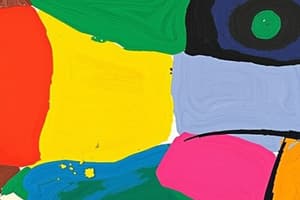Podcast
Questions and Answers
What is the term used to describe the first visual records of human existence, created by early humans using natural materials like charcoal and pigments made from minerals and plants?
What is the term used to describe the first visual records of human existence, created by early humans using natural materials like charcoal and pigments made from minerals and plants?
Prehistoric Art
During which art period did artists like Leonardo da Vinci, Michelangelo, and Raphael use perspective, chiaroscuro, and anatomy to create highly realistic images?
During which art period did artists like Leonardo da Vinci, Michelangelo, and Raphael use perspective, chiaroscuro, and anatomy to create highly realistic images?
Renaissance Art
Which art period is characterized by an exuberant, theatrical style that emphasized emotion and movement in artworks?
Which art period is characterized by an exuberant, theatrical style that emphasized emotion and movement in artworks?
Baroque Art
Name a key feature of Medieval Art that distinguishes it from other art periods.
Name a key feature of Medieval Art that distinguishes it from other art periods.
What type of art is characterized by monumental architecture, sculpture, and painting, such as the frescoes of Pompeii and the Parthenon frieze?
What type of art is characterized by monumental architecture, sculpture, and painting, such as the frescoes of Pompeii and the Parthenon frieze?
Which era in art history featured abstract expressions and marked a departure from traditional forms of art?
Which era in art history featured abstract expressions and marked a departure from traditional forms of art?
What are the four ways art can be categorized?
What are the four ways art can be categorized?
How can appreciating art be achieved?
How can appreciating art be achieved?
Name three traditional genres of art.
Name three traditional genres of art.
What are some examples of art movements mentioned in the text?
What are some examples of art movements mentioned in the text?
What is the importance of understanding the historical and cultural context of an artwork?
What is the importance of understanding the historical and cultural context of an artwork?
What are some common assumptions about art discussed in the text?
What are some common assumptions about art discussed in the text?
Flashcards are hidden until you start studying
Study Notes
Introduction
Art is a form of human expression dating back thousands of years, used by various cultures across the globe to communicate ideas, tell stories, express emotions, and record history. This article will delve into the world of art, exploring its history, categorization, appreciation, and assumptions associated with it.
Art History
The evolution of art spans many centuries, with each era reflecting its unique cultural context and societal values. From the cave paintings of Lascaux to the abstract expressions of the modern era, art has undergone numerous transformations that have shaped our understanding of human creativity. Some key periods include:
- Prehistoric Art: The first visual records of human existence, created by early humans using natural materials like charcoal and pigments made from minerals and plants.
- Ancient Art: Characterized by monumental architecture, sculpture, and painting, such as the frescoes of Pompeii and the Parthenon frieze.
- Medieval Art: A period of religious art, featuring illuminated manuscripts, stained-glass windows, and ecclesiastical sculptures.
- Renaissance Art: A revival of classical forms and techniques, with artists like Leonardo da Vinci, Michelangelo, and Raphael using perspective, chiaroscuro, and anatomy to create highly realistic images.
- Baroque Art: An exuberant, theatrical style that emphasized emotion and movement, as seen in the works of Caravaggio and Rembrandt.
- Modern Art: A diverse movement that challenged traditional notions of beauty and representation, with artists like Pablo Picasso, Salvador Dalí, and Jackson Pollock pioneering new styles and techniques.
Art Categorization
Art can be categorized in various ways, including:
- Genre: Traditional genres of art include landscape, portrait, still life, and genre painting, which depicts scenes from everyday life.
- Style: This refers to the manner in which an artist creates their work, such as realism, impressionism, expressionism, and abstract expressionism.
- Medium: Artists work in a variety of mediums, including painting, sculpture, printmaking, photography, and digital art.
- Movement: Art movements are groups of artists who share similar artistic and philosophical perspectives, such as the Impressionists, Surrealists, and Pop Artists.
Art Appreciation
Appreciating art involves understanding its historical and cultural context, recognizing its technical skill, and experiencing its emotional impact. This can be achieved through:
- Education: Learning about the history and evolution of art can deepen our appreciation for the works we encounter.
- Observation: Carefully examining an artwork can reveal its technical skill and artistic intent.
- Contextualization: Understanding the historical and cultural context in which an artwork was created can enhance our appreciation of its significance.
- Emotional Response: Art evokes emotions, and acknowledging our emotional responses to a work can help us understand its impact.
Assumptions in Art
Assumptions in art can be both positive and negative, influencing how we perceive and value works. Some common assumptions include:
- Art is a luxury: Some people may view art as a frivolous pursuit, unimportant compared to more practical concerns like healthcare or education.
- Art is just for the elite: People who believe this assumption may feel intimidated by museums or galleries because they assume they don't have enough knowledge to appreciate the works on display.
- Art is subjective: While individual interpretations can vary, there are fundamental principles of good art that apply across cultures and time periods.
- Art is just for artists: Those who hold this belief might think that creating art requires special talents beyond their reach.
In conclusion, art encompasses a wide range of expressions throughout history, from prehistoric times to contemporary movements. Understanding art history, appreciating its value, and recognizing common assumptions can help us better understand and engage with this vast field of human creativity.
Studying That Suits You
Use AI to generate personalized quizzes and flashcards to suit your learning preferences.




